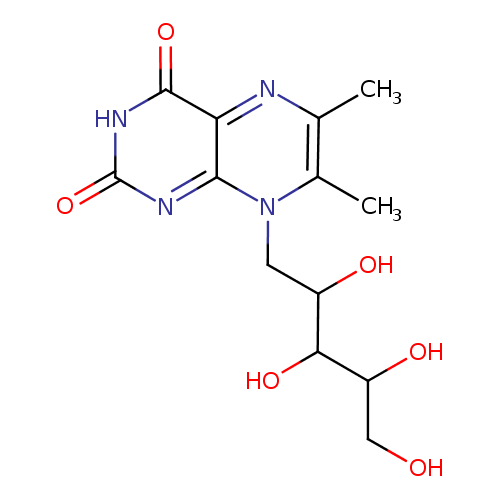|
Record Information |
|---|
| Version |
1.0 |
|---|
| Update Date |
1/22/2018 11:54:54 AM |
|---|
|
Metabolite ID | PAMDB110734 |
|---|
|
Identification |
|---|
| Name: |
6,7-dimethyl-8-(1-D-ribityl)lumazine |
|---|
| Description: | The anion formed from 6,7-dimethyl-8-(1-D-ribityl)lumazine by removal of a proton from the nitrogen at position 3 (i.e. between the oxo groups). It is the major species at physiological pH. |
|---|
|
Structure |
|
|---|
| Synonyms: | |
|---|
|
Chemical Formula: |
C13H17N4O6
|
|---|
| Average Molecular Weight: |
325.3 |
|---|
| Monoisotopic Molecular
Weight: |
326.1226343312 |
|---|
| InChI Key: |
SXDXRJZUAJBNFL-XKSSXDPKSA-M |
|---|
| InChI: |
InChI=1S/C13H18N4O6/c1-5-6(2)17(3-7(19)10(21)8(20)4-18)11-9(14-5)12(22)16-13(23)15-11/h7-8,10,18-21H,3-4H2,1-2H3,(H,16,22,23)/p-1/t7-,8+,10-/m0/s1 |
|---|
| CAS
number: |
5118-16-1 |
|---|
| IUPAC Name: | 1-deoxy-1-(6,7-dimethyl-2,4-dioxo-2H-pteridin-3-id-8(4H)-yl)-D-ribitol |
|---|
|
Traditional IUPAC Name: |
6,7-dimethyl-8-(2,3,4,5-tetrahydroxypentyl)-3H-pteridine-2,4-dione |
|---|
| SMILES: | CC2(=C(C)N(CC(O)C(O)C(O)CO)C1(C(C(=O)[N-]C(=O)N=1)=N2)) |
|---|
|
Chemical Taxonomy |
|---|
|
Taxonomy Description | This compound belongs to the class of chemical entities known as pteridines and derivatives. These are polycyclic aromatic compounds containing a pteridine moiety, which consists of a pyrimidine fused to a pyrazine ring to form pyrimido(4,5-b)pyrazine. |
|---|
|
Kingdom |
Chemical entities |
|---|
| Super Class | Organic compounds |
|---|
|
Class |
Organoheterocyclic compounds |
|---|
| Sub Class | Pteridines and derivatives |
|---|
|
Direct Parent |
Pteridines and derivatives |
|---|
| Alternative Parents |
|
|---|
| Substituents |
- Pteridine
- Pyrimidone
- Pyrazine
- Pyrimidine
- Heteroaromatic compound
- Vinylogous amide
- Lactam
- Secondary alcohol
- Polyol
- Azacycle
- Organic oxide
- Organopnictogen compound
- Organic oxygen compound
- Primary alcohol
- Alcohol
- Organooxygen compound
- Organonitrogen compound
- Organic nitrogen compound
- Hydrocarbon derivative
- Aromatic heteropolycyclic compound
|
|---|
| Molecular Framework |
Aromatic heteropolycyclic compounds |
|---|
| External Descriptors |
Not Available |
|---|
|
Physical Properties |
|---|
| State: |
Solid |
|---|
| Charge: | -1 |
|---|
|
Melting point: |
Not Available |
|---|
| Experimental Properties: |
| Property | Value | Reference |
|---|
| Melting Point | Not Available | Not Available | | Boiling Point | Not Available | Not Available | | Water Solubility | Not Available | Not Available | | LogP | -3.145 | Not Available |
|
|---|
| Predicted Properties |
|
|---|
|
Biological Properties |
|---|
| Cellular Locations: |
Not Available |
|---|
| Reactions: | |
|---|
|
Pathways: |
|
|---|
|
Spectra |
|---|
| Spectra: |
|
|---|
|
References |
|---|
| References: |
Not Available |
|---|
| Synthesis Reference: |
Not Available |
|---|
| Material Safety Data Sheet (MSDS) |
Not Available |
|---|
|
Links |
|---|
| External Links: |
|
|---|


